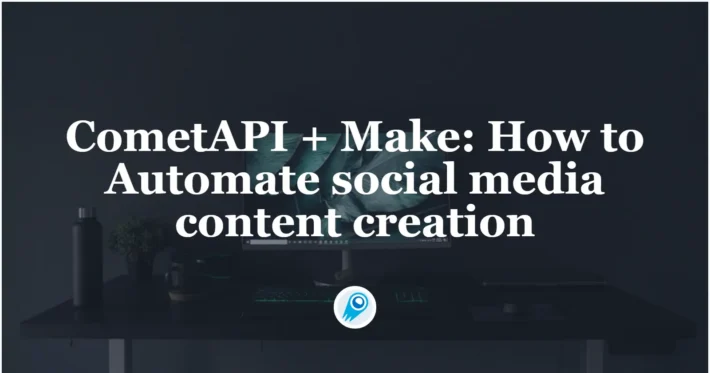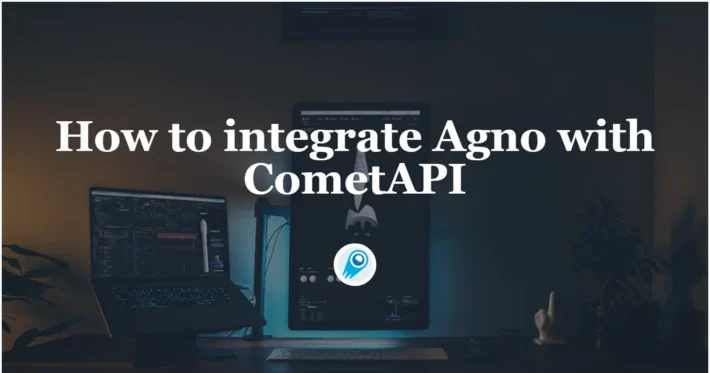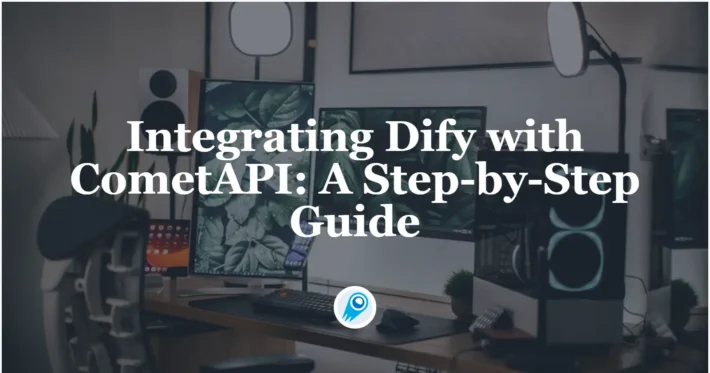How Do Developers Connect Activepieces with CometAPI in Practice

Integrating a powerful automation platform like Activepieces with a unified AI access layer such as CometAPI lets teams add model-powered steps to visual workflows without writing glue code. This article explains what each product is, why you would combine them, what you must prepare, and a clear step-by-step walkthrough (using the CometAPI “piece” maintained in the Activepieces community). You’ll also get best practices and concrete use cases so you can design reliable, secure automations.
What is Activepieces?
Activepieces is an open, no-code / low-code automation platform that uses a “piece” model — modular connector components (pieces) that expose triggers and actions you can drag onto a canvas to build flows. It’s designed to be extensible (community and developer contributions), supports cloud and self-hosted deployments, and exposes APIs and a CLI for advanced automation lifecycle tasks (create flows, manage projects, publish or sync custom pieces). The environment is visual (flows, triggers, actions) with support for code pieces when you need custom logic.
How Activepieces structures automation
Extensibility: The pieces framework and developer tools let the community add new pieces or publish versions to a private registry or instance.
Projects & Flows: Work is organized into projects and flows; a flow is a sequence of trigger → actions.
Pieces: Each connector (e.g., Slack, Google Sheets, CometAPI) is implemented as a “piece” exposing re-usable actions and triggers.
What is CometAPI and what does it bring to the table?
CometAPI is a unified AI model marketplace and API gateway that provides access to hundreds of LLMs, image and multimedia models, and other model families through a single, consistent REST API. Instead of integrating dozens of vendor-specific SDKs, developers can call https://api.cometapi.com/v1/chat/completions (and other endpoints) and choose which model to run via a model parameter; authentication is handled with a bearer API key. CometAPI positions itself as a cost-control and portability layer, with documentation and token/key management on the CometAPI dashboard.
CometAPI’s offering is attractive in automation contexts because it lets you: (a) pick the right model for the task (cost vs quality), (b) switch models with minimal code changes, and (c) access specialized models for summarization, search-augmented generation, multimodal tasks, or agentic workflows — all of which expand what you can do inside an Activepieces flow.
Why integrate Activepieces with CometAPI?
Combining Activepieces and CometAPI gives you the best of both worlds: the visual orchestration and automation of Activepieces, and the flexible, multi-model AI access of CometAPI. Key benefits:
- Rapid prototyping: Drag a CometAPI action into a flow to add summarization, text generation, embeddings, or image generation to any automation without writing HTTP glue. (Activepieces provides a CometAPI piece in the pieces catalog.)
- Model portability: Because CometAPI exposes many models behind one API, you can experiment with different providers or model families without changing your workflow logic.
- Operational simplicity: Use Activepieces for retries, branching, and integrations to systems (databases, messaging, sheets) while delegating all AI interaction to CometAPI.
- Cost & vendor management: Centralizing model selection through CometAPI helps control spend and switch to cheaper models where appropriate.
What environment and prerequisites do you need before integrating?
1) Accounts and access
- An Activepieces account (Cloud) or a running self-hosted Activepieces instance with admin/project access to create flows and connections. If you host on your own, ensure your deployment version supports the pieces you want to use.
- A CometAPI account and an API key (token). You’ll need this token to authenticate from Activepieces. CometAPI exposes token management in the dashboard (“API Keys” / “Add Token”).
2) Security posture
A secrets management policy: never commit API keys to source control. Use Activepieces’ connection storage (or global connections) to keep API tokens encrypted and scoped to projects.
3) Basic flow design decisions
Identify triggers (schedule, webhook, new ticket in a helpdesk) and where AI should run (pre-processor, classifier, summarizer, content generator). Decide which CometAPI model family suits each task (cheap embeddings vs higher-cost chat models).
How do I integrate Activepieces with CometAPI?
Below is a practical, UI-focused walkthrough that follows the Activepieces flow builder UX and the CometAPI authentication model. The steps assume you already have the CometAPI API key and log in Activepieces.
Step 1 — Enter your personal project in Activepieces
- Log into Activepieces (cloud or self-hosted).
- From the dashboard, open or create the project you want to use for the flow. Projects scope flows, connections and templates.
Step 2 — Create a new flow
Choose From Scratch (often the dialog lists templates — select the empty “scratch” option to design a custom flow). This opens the flow builder canvas. (Activepieces docs and tutorials show the New Flow → From Scratch flow as the common pattern.)
In the left nav click Flows → New Flow (or Create Flow).
Step 3 — Create a scratch/test flow (sandbox)
Use a scratch flow (a throwaway flow) when experimenting so you don’t interfere with production logic. Click Create Scratch or create a flow named scratch/cometapi-test to keep it organized.
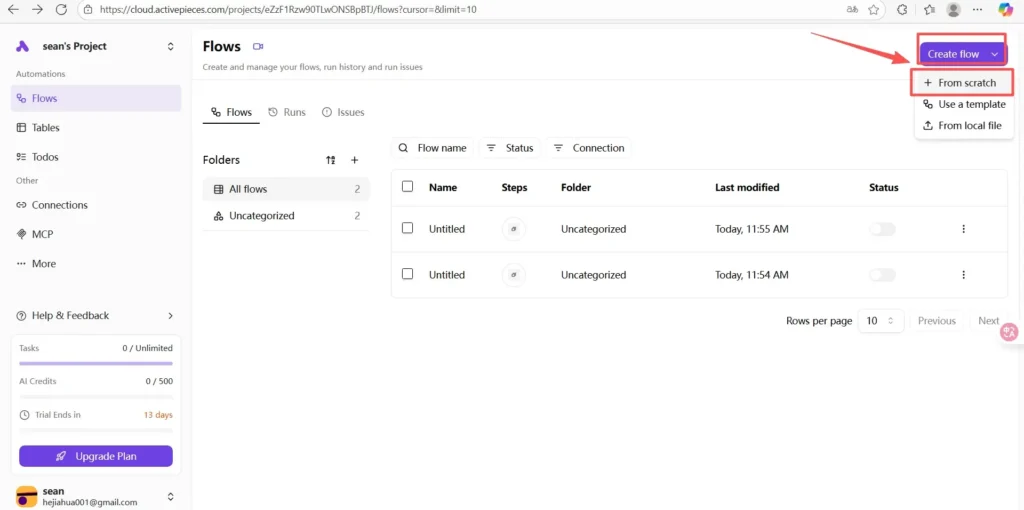
Step 4 — Add the CometAPI piece to your flow
- In the flow canvas, click the + (plus sign) where you want to insert an action.
- In the search box that appears, type “cometapi” and select the CometAPI piece from the catalog. Activepieces lists community and official pieces in the same search; pick the CometAPI node provided by the Activepieces community if that’s the one you want.
- Create Connection,In the CometAPI piece configuration you will be prompted to set up authentication. Most Activepieces pieces that call external REST APIs use an API-key style auth.
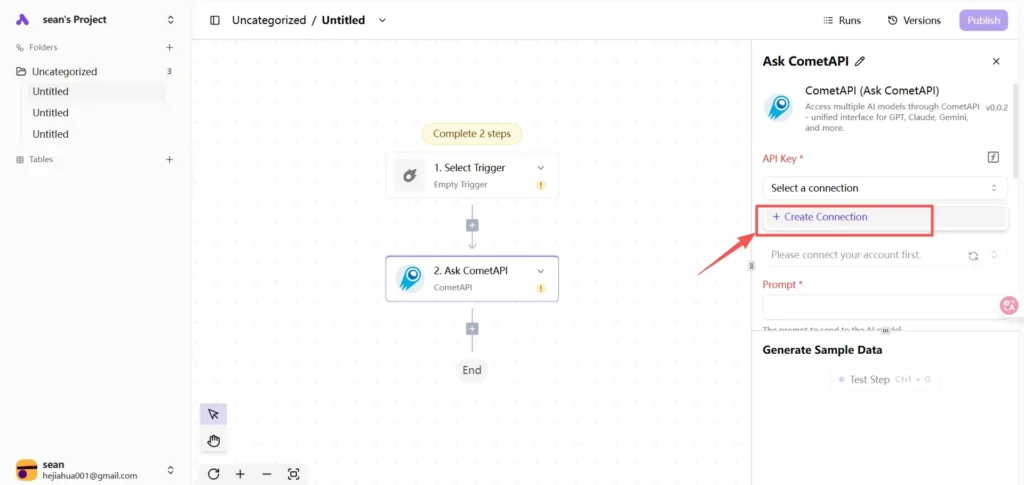
Step 5 — Configure the CometAPI action fields
For Ask CometAPI, fill in:
- Model — choose a model available in CometAPI (e.g.,
gpt-oss-20b,gpt-5,grok-4, or lighter models depending on cost). - Prompt — the user prompt or conversation messages; you can reference earlier step outputs using Activepieces’ data selectors.
- System message (optional) — high-level instruction to the model.
- Temperature, Max tokens, Top-p — tuning parameters.
For Custom API Call (if you need lower-level control), set:
- URL:
https://api.cometapi.com/v1/chat/completions(or another CometAPI endpoint). - Method:
POST. - Headers:
Authorization: Bearer {{connection.api_key}}andContent-Type: application/json. - Body: JSON body with
model,messages/prompt, and other params.
Activepieces exposes the response as a variable you can use in subsequent steps.
Example: minimal Custom API Call body
{
"model": "gpt-oss-20b",
"messages": [
{"role": "system", "content": "You are a helpful assistant."},
{"role": "user", "content": "Summarize the following ticket: {{steps.trigger.data.ticket_text}}"}
],
"temperature": 0.2,
"max_tokens_to_sample": 300
}Set the headers to include Authorization: Bearer <YOUR_COMETAPI_KEY> (Activepieces will substitute the connection secret if you store the key in a connection).
Step 6 — Test the flow and iterate
- Run the flow in test mode. Inspect the action’s logs and the raw response from CometAPI to verify the model selection, token usage, and output shape.
- If you need more control or observability, add a log or HTTP action after the CometAPI action to capture the response to a datastore or to a webhook for further processing.
- When satisfied, promote the flow from scratch/test to a named production flow. Use versioning or project folders to track changes.
What real-world use cases are ideal for this integration?
Here are pragmatic examples where Activepieces + CometAPI adds immediate value.
Automated content pipelines
Blog or product copy generation: Triggered by a new row in Airtable or Google Sheets, call CometAPI to draft copy, then push drafts to a CMS. Activepieces handles the orchestration and approvals; CometAPI supplies generative text.
Summarization and ticket triage
Customer support triage: When an incoming email or webhook creates a ticket, a flow calls CometAPI to summarize and extract priority, topic, and suggested assignees. Activepieces then routes the ticket to the right queue. This reduces manual review time.
Semantic search and knowledge augmentation
Embeddings + vector store: Use CometAPI to generate embeddings for documents; store vectors in a database and run similarity searches to power knowledge-base lookup in chatbots or internal tools. Activepieces orchestrates ingestion and update schedules.
Multi-step AI workflows
Image generation + postprocessing: A flow calls CometAPI to generate an image, then pipes the result into an image processing service, uploads it to storage, and posts a link to Slack. Activepieces manages retries, permissions, and downstream notifications.
Cross-platform automation (Make / n8n / Activepieces)
Hybrid automations: If your org uses other workflow tools (Make, n8n), CometAPI can be the common AI backend across platforms; Activepieces can both call and be called in multi-tool orchestrations. CometAPI’s presence in many automation catalogs (n8n, Make) emphasizes its role as a central AI API.
Getting Started
CometAPI is a unified API platform that aggregates over 500 AI models from leading providers—such as OpenAI’s GPT series, Google’s Gemini, Anthropic’s Claude, Midjourney, Suno, and more—into a single, developer-friendly interface. By offering consistent authentication, request formatting, and response handling, CometAPI dramatically simplifies the integration of AI capabilities into your applications. Whether you’re building chatbots, image generators, music composers, or data‐driven analytics pipelines, CometAPI lets you iterate faster, control costs, and remain vendor-agnostic—all while tapping into the latest breakthroughs across the AI ecosystem.
To begin, explore the model’s capabilities in the Playground and consult the Activepieces Integration Guide for detailed instructions. Before accessing, please make sure you have logged in to CometAPI and obtained the API key. CometAPI offer a price far lower than the official price to help you integrate.
Ready to Go?→ Sign up for CometAPI today !
Conclusion
Integrating Activepieces with CometAPI is a practical way to inject AI into your automations without distributed, fragile custom code. Start with a sandbox flow, wire the CometAPI piece using a secure connection for your API key, and iterate with conservative model settings and good logging. Because CometAPI unifies many models under one API and Activepieces makes orchestration visual and repeatable, the combination accelerates both experimentation and production roll-outs.

